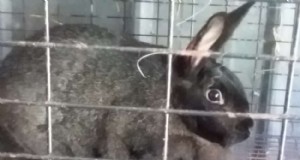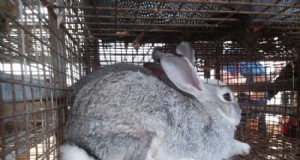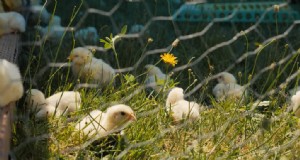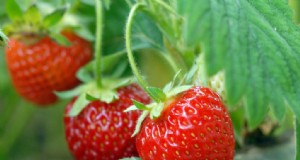Aprender a criar porcos para carne é uma ótima opção para qualquer propriedade ou fazenda que queira se tornar mais autossustentável. Mas escolher a raça e adequar os cuidados exige um pouco de know-how. Leia as 12 dicas para criar porcos para carne.
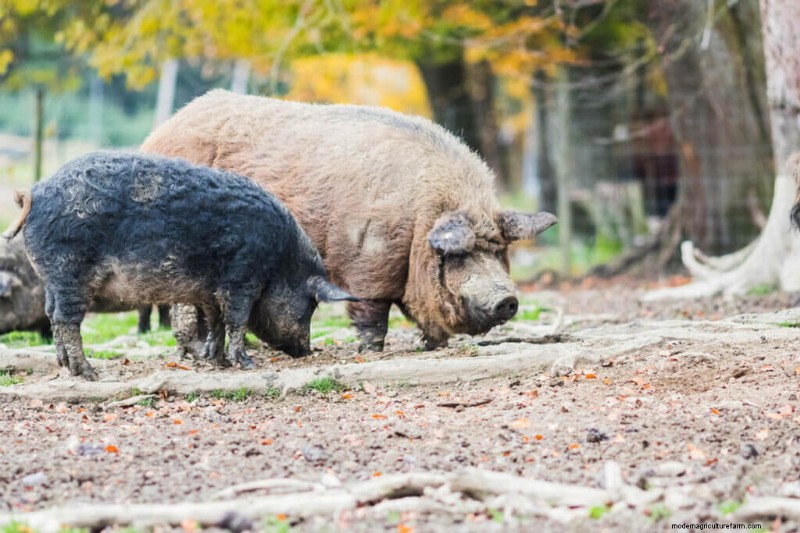 Esta postagem foi originalmente escrita e publicada em 2015 por Amy do Autumn Creek Ranch e desde então foi atualizada para incluir minha entrevista com “Pork” Rhyne Cureton para ainda mais informações. Aproveite!
Esta postagem foi originalmente escrita e publicada em 2015 por Amy do Autumn Creek Ranch e desde então foi atualizada para incluir minha entrevista com “Pork” Rhyne Cureton para ainda mais informações. Aproveite! Em podcasts anteriores, discuti
como criei Porquinhos-da-índia americanos e por que escolhemos essa raça específica. E em outro podcast eu discuti
se pensávamos ou não que valia a pena criar porcos-da-índia para carne , incluindo se vamos aumentá-los novamente ou não.
O convidado do podcast de hoje (Pioneering Today Podcast episódio #331) é “Pork” Rhyne e eu tive a sorte de conhecê-lo na
Conferência Homesteader's of America . Eu mal podia esperar para colocá-lo no podcast para discutir tudo sobre porcos!
“Pork” Rhyne trabalha como educador agrícola internacional e especialista em marketing de carne de nicho. Ele dedicou sua vida a treinar e educar agricultores experientes e iniciantes em negócios e marketing. (Leia até o final deste post onde você pode encontrar carne de porco online!)
Se você ainda não está pronto para criar sua própria carne, ou seja, carne de porco, já que esse é o assunto do dia, quero recomendar
Butcher Box .
A Butcher Box é patrocinadora do Podcast Pioneering Today e eles têm um evento especial acontecendo até 20 de janeiro de 2022, chamado Pacote de Ano Novo. Neste pacote, apenas para assinantes de primeira viagem, você receberá 7 libras de carne GRATUITAMENTE em sua primeira caixa! Acesse
butcherbox.com/pioneeringtoday para se inscrever!
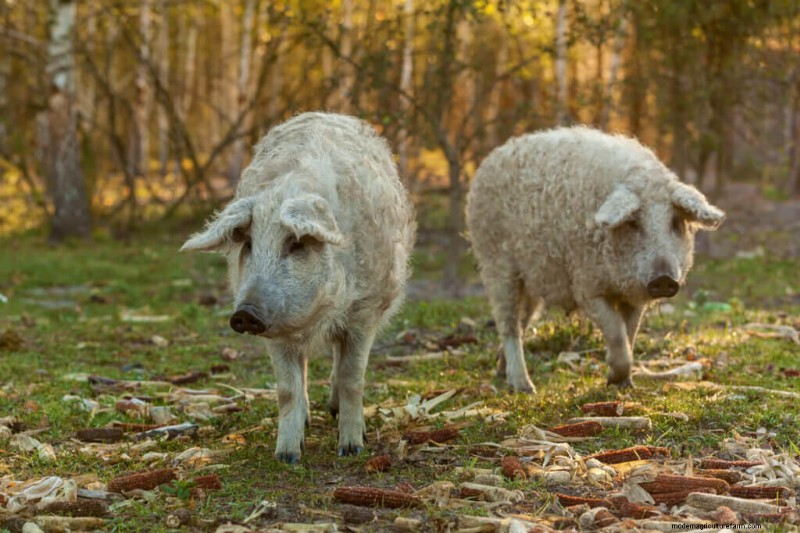
Por que adoro criar porcos
Eu realmente acho que os porcos são um dos animais mais fáceis de criar em uma propriedade. Eles amadurecem um pouco mais rápido do que uma vaca de corte e rendem muito mais carne (e banha) do que um frango ou coelho (e francamente carne de porco desfiada, bacon fresco,
banha feita em casa , e
presuntos salgados são simplesmente incríveis!!!).
Outros animais para criar
Antes de começar a criar porcos, para obter mais informações sobre como criar sua própria carne, verifique este post sobre
planejar seu gado e criar carne suficiente para um ano de alimentos . Bem como o seguinte para outras postagens específicas de animais:
- R criação de galinhas poedeiras no quintal
- Criação de aves de corte no quintal
- Como criar uma vaca leiteira
- Criação de coelhos de carne
- Criação de ovelhas (para fibra)
- Um guia para criar cabras
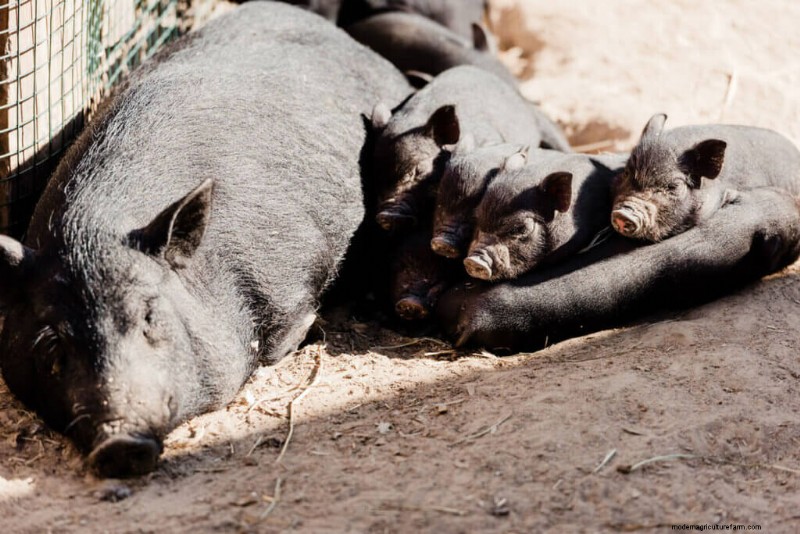
12 dicas para criar porcos
Então, talvez você tenha pensado em criar um porco (ou dois) e não sabe por onde começar? Aqui estão algumas dicas e sugestões que espero que o ajudem em seu caminho para
criar sua própria deliciosa carne de porco .
Compre Leitões
Para alguém interessado em criar apenas alguns porcos por ano para carne, é mais fácil comprar leitões do que criar seu próprio plantel.
Os leitões variam de preço devido à localização, época do ano (eles são mais caros na primavera, quando as crianças em 4-H estão tentando encontrá-los) e por raça.
No momento original da redação deste post (2015), os leitões eram vendidos por cerca de $ 125 / cada, mas podiam ser encontrados a partir de $ 75, dependendo da demanda do mercado.
(Os preços provavelmente estão mais altos agora.) 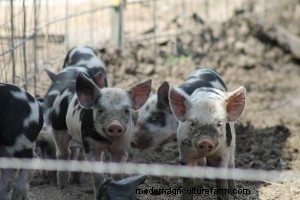
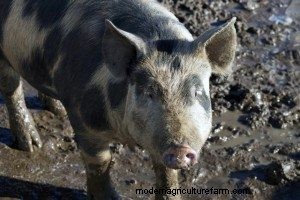
A idade importa
O padrão da indústria para a venda de leitões é de 6 semanas de idade. No entanto, vendemos os nossos leitões com 8 semanas de idade porque descobrimos que os leitões autorizados a permanecer com a porca nessas duas semanas extras têm sistemas imunológicos mais fortes e não precisam ser alimentados com ração inicial.
Claro, isso significa que temos que alimentar a porca extra para manter sua condição, mas achamos que os leitões mais saudáveis valem a pena.
Se você puder encontrar leitões que foram autorizados a mamar um pouco mais, vale a pena o custo extra, pois você economizará tanto na sua conta de ração quanto em possíveis problemas de saúde para o leitão.
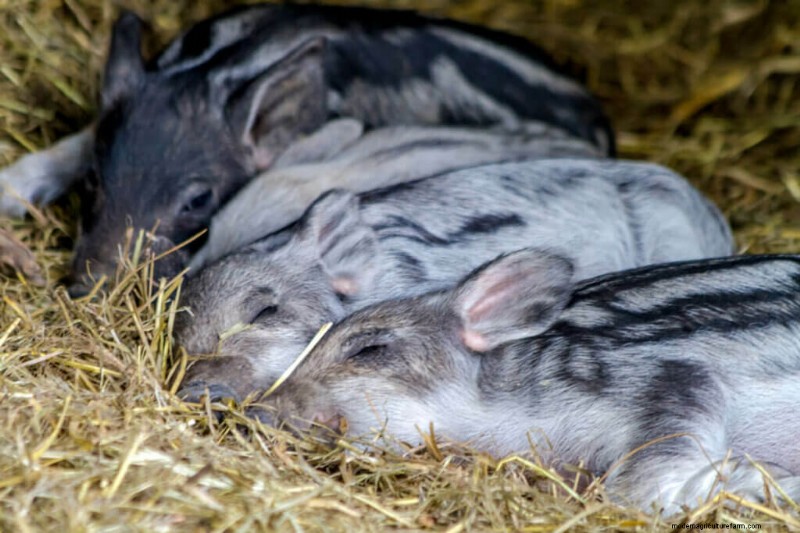
Considerações de espaço
Antes de trazer os leitões para casa, você precisa ter um cercado e algum tipo de abrigo para eles. Falarei mais sobre esgrima em um minuto, mas há algumas considerações a serem feitas ao planejar seu curral.
Se a baia for pequena, os leitões crescerão mais rápido porque não terão muito espaço para se exercitar e o chão pode ficar muito destruído.
Além disso, em uma área menor, os parasitas têm mais chance de crescer. Finalmente, um pequeno curral na primavera, quando o tempo está úmido, pode resultar em um grande poço de lama.
No entanto, como Pork Rhyne discute na entrevista do podcast, isso não significa que você deve ter espaço para criar ou pastar seus porcos. Criar seus próprios porcos é um grande avanço em relação à compra de produtos suínos criados comercialmente, mesmo que você não tenha as condições de vida ideais para esses porcos.
Preferimos usar áreas rotativas nos meses mais quentes e áreas realmente grandes perto da casa nos meses mais frios (na verdade, colocamos porcos em nossas áreas de jardim durante o inverno para que possam cultivá-los e fertilizá-los em preparação para o plantio na primavera).
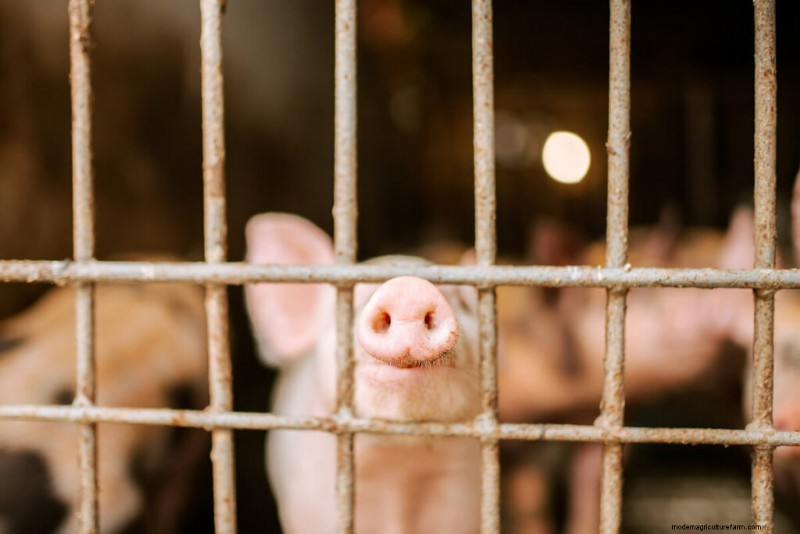
Esgrima
Quando os leitões são jovens, é melhor que eles fiquem em um painel de gado, painel de suínos ou cercado de paletes.
Rede elétrica, corda ou arame não funcionam bem com leitões pequenos porque eles podem escapar (falado com muita experiência e um leitão que fugiu por duas semanas na floresta ao redor de nossa propriedade).
Mantemos os leitões em uma pequena baia de painel de gado com fio elétrico no fundo até que tenham cerca de 12 a 15 semanas de idade e depois os transferimos para baias feitas com fio ou fio elétrico até atingirem o peso de abate.
Normalmente, por volta de 12 a 15 semanas, eles são treinados para o elétrico e são grandes o suficiente para não mexer com isso. No entanto, é bom ter uma saída ou portão que não seja elétrico. Os porcos podem ser tão bem treinados para cercas elétricas que, quando queremos movê-los, eles não se aproximam de um local que costumava ter cercas elétricas.
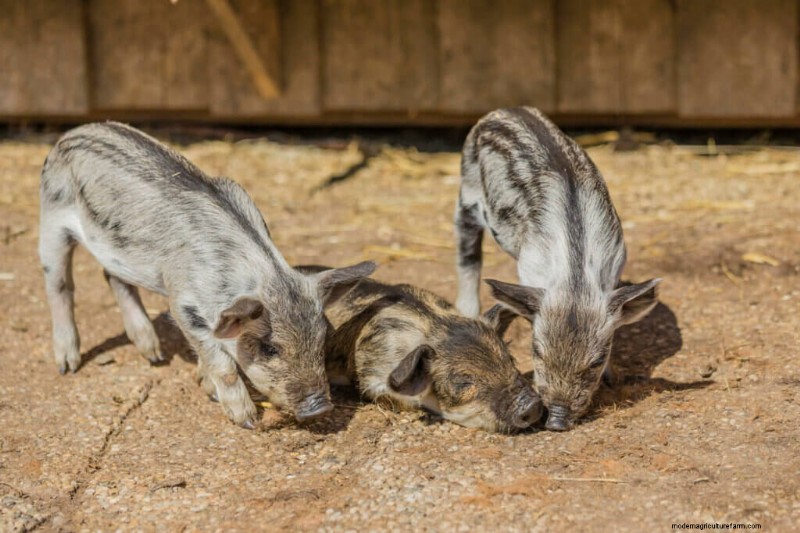
Alimentando Porcos
Existem muitas maneiras possíveis de alimentar seu porco. O mais fácil é comprar um produtor comercial de suínos. Os porcos crescem mais rápido com este tipo de ração. Infelizmente, a maioria das fórmulas comerciais para criadores de suínos contém milho e soja, que provavelmente são transgênicos.
Muitos alimentos comerciais também contêm medicamentos que podem ou não ser necessários para o seu animal em particular.
Uma vez que não gostamos de dar medicamentos desnecessariamente aos nossos animais, outra opção é fazer a sua própria ração a partir de uma fonte de cereais e proteínas ou encontrar uma ração natural pré-fabricada na sua zona.
Aqui está o que Pork Rhyne tem a dizer sobre a alimentação de porcos... Há muita controvérsia sobre como alimentar seus porcos, tudo, desde ir à padaria local e alimentar os porcos com pão do dia anterior, até comprar apenas a melhor ração orgânica e não transgênica.
Há tantas pessoas que estão apenas começando a criar porcos que na verdade não sabem como é um porco saudável. Por isso, ele recomenda passar um tempo com outra pessoa que cria porcos para aprender e se acostumar com o quanto os porcos devem comer, como seus apetites variam de acordo com as estações do ano e como é um porco saudável.
Nós, colonos, adoramos a rota alternativa, sempre que pudermos DIY ou tivermos uma maneira alternativa de fazer algo, vamos pular nela! Acho que é da nossa natureza. Mas antes de começar a fazer sua própria ração para suínos, é importante entender os componentes da ração para saber como alimentar um porco para obter um produto com uma proporção de gordura:carne que o deixe satisfeito na hora de abater.
- Carboidratos – fonte de energia, muitas vezes milho ou grão
- Fonte de proteína – feijão de soja, feijão de campo, etc.
- Fibras/Minerais/etc – estes irão compor o resto da ração para ajudar a manter os porcos saudáveis
Uma vez que você tenha os componentes básicos da ração, também é importante saber sobre sua raça específica, porque cada raça terá diferentes necessidades de carboidratos e proteínas.
Quando se trata de Porquinhos-da-índia americanos, eles são propensos à obesidade, então precisam de uma dieta com menos carboidratos para evitar o excesso de gordura nos porcos.
Pork Rhyne tinha um amigo que estava muito desapontado com a quantidade de carne para a proporção de gordura que ele obteve depois de abater seus porcos, mas descobriu-se que ele estava alimentando seus porcos com 16% de proteína bruta durante toda a vida, em vez de reduzir a proteína antes do abate. .
Normalmente, cerca de 2 a 3 meses antes do abate, Pork Rhyne recomenda reduzir a quantidade de proteína para 12 a 14% e aumentar a quantidade de carboidratos para transformar essa energia em gordura.
Como eu disse acima, tudo isso varia entre as raças e é diferente para herefords, raças tradicionais, raças comerciais, etc.
Além da ração pré-fabricada, os porcos adoram todos os tipos de produtos. Você pode até mesmo cultivar colheitas específicas para seus porcos, como mangels, nabos forrageiros, beterrabas e abóboras.
Em nossa fazenda, alimentamos uma combinação de cevada e ervilhas de origem local com adição de minerais suínos. Nossos porcos também recebem muito leite fresco, restos de comida, maçãs e abóboras locais.
Por favor, não alimente seus porcos com restos de panificação e afins e espere um porco saudável com carne saborosa. Você come o que seu porco come, então a qualidade é importante.
Outro exemplo de maneiras de alimentar porcos é que Pork Rhyne tem um amigo que foi ao Chipotle (uma rede de restaurantes fast-food) e pegou grãos que não foram vendidos aos consumidores para alimentar seus porcos.
Eu sou a favor de ser engenhoso! Apenas certifique-se de que a comida que você está recebendo não seja pós-consumo (o que significa que não foi servida primeiro a um cliente e depois jogada no lixo porque isso espalhará doenças para seus porcos) e certifique-se de que não há carne de porco no produto.
Uma coisa que adoro fazer é fornecer meu feed o mais localmente possível. Temos um celeiro a cerca de uma hora de distância que tem uma postura não transgênica e também tenta obter seus grãos o mais localmente possível. Para dicas de economia de dinheiro na compra de seu celeiro local, confira Stocking Up on Animal Feed (+ How Much to Feed Animals).
Também saiba, se você está alimentando seus porcos com grãos gastos (como grãos cervejeiros que você pode obter de uma cervejaria), cerca de 80% é água. Por exemplo, se esse grão estiver seco, conterá cerca de 29% de proteína, enquanto que uma vez que o grão esteja úmido (ou gasto), ele contém apenas 7,7% de proteína bruta.
O grão usado também fica mofado muito rapidamente, então Pork Rhyne recomenda isso como um complemento à dieta, não a fonte primária.
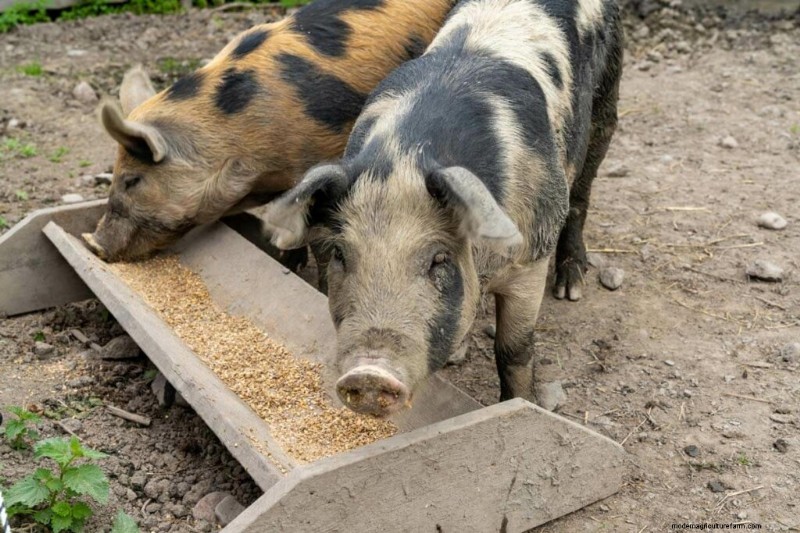
Demanda x alimentação medida
Outra coisa a considerar ao criar porcos é se deve configurar um comedouro automático e deixar os porcos comerem quando quiserem ou alimentá-los com uma quantidade definida todos os dias.
Existem prós e contras para ambos. A alimentação sob demanda reduz a carga de trabalho diária, exceto no dia em que você precisa encher o comedouro de suínos. Além disso, se os porcos sempre tiverem comida disponível, eles estarão menos propensos a fuçar tanto e assim seu solo ficará em melhor forma. Os porcos que são alimentados sob demanda também tendem a crescer mais rápido, portanto, seu tempo até a maturidade é menor.
O problema com a alimentação sob demanda é que os porcos podem comer MUITA comida e isso pode ficar caro, especialmente à medida que os porcos envelhecem.
Descobrimos que, se você está criando apenas um ou dois porcos, a alimentação sob demanda é o caminho a percorrer. Quando você está levantando 10 ou mais é quando pode se tornar um custo proibitivo.
Damos a cada um de nossos leitões 5 libras de sua mistura de grãos todos os dias. Além disso, recebem leite, restos de comida e produtos agrícolas.
Isso nos permite ter porcos com peso de mercado por volta dos 8 meses.
Medicamentos e desparasitação (DIY De-wormer)
Não sou fã de vermífugos químicos por causa das mutações e resistências que eles criam.
Em nossa fazenda, descobrimos que o alho é um vermífugo muito mais eficaz.
Adicionamos aproximadamente 1 lb de grânulos de alho a uma tonelada de ração.
Além disso, o óleo de orégano também é excelente no combate a parasitas e infecções.
Por fim, mantemos o óleo essencial de gerânio à mão para sangramento (porcos podem entrar em brigas) e óleo de tea tree para cortes e arranhões.
Castrar ou não?
A castração de porcos é um assunto controverso. Há muitos que acham a prática cruel e desnecessária, mas outros dizem que ela precisa ser feita para prevenir o odor de macho inteiro.
Se você estiver criando dois porcos machos, precisará determinar se deseja realizar esse procedimento.
No entanto, quando você está criando leitões do sexo oposto, é aconselhável ir em frente e castrar. Quando começamos a criar leitões, fomos informados de que eles não começariam a se reproduzir até os 9 meses de idade. Como matamos aos 8 meses, não achamos que precisávamos castrar.
Maus conselhos e acabamos com porcos prenhas no mercado. Agora castramos todos os leitões machos criados para carne. Encontramos o
Remédio de resgate de Bach muito útil no processo – mantém os porcos e a pessoa que faz a castração calmos.
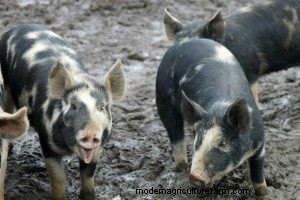
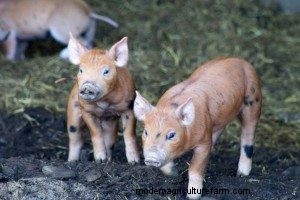
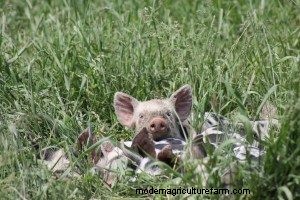
As raças importam
Diferentes raças de porcos têm diferentes qualidades, incluindo diferenças de tamanho, qualidade da carne e temperamento.
Essas são coisas que você deve investigar ao escolher seus leitões antes de trazê-los para casa.
Criamos raças tradicionais de porcos (Gloucester Old Spot, American Guinea Hog, Tamworth) por causa de seu temperamento dócil e amigável e excelente qualidade de carne.
A cobaia americana é uma raça de porco muito menor e não produzirá um peso de carcaça convencional, mas devido à sua facilidade de manuseio e carne de qualidade de chef, é uma compensação que estamos dispostos a fazer.
Os primeiros porcos de Pork Rhyne eram na verdade uma raça tradicional chamada “large blacks” e “red wobble”, ele também criou alguns cruzamentos e porcos comerciais.
200 anos atrás, os porcos não eram alimentados com as dietas que recebem agora. Eles eram animais de baixo consumo, assim como galinhas, onde eram alimentados com restos da cozinha ou jardim, soltos e ruminando, etc.
Por muitos anos, os porcos foram os “à prova de falhas”. Se uma safra tivesse uma colheita ruim em um ano, as famílias sempre teriam porcos para vender para sobreviver.
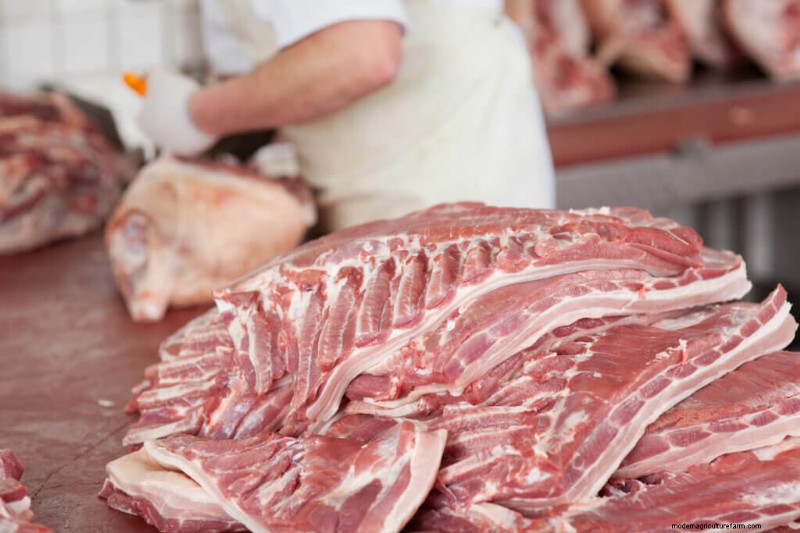
Peso de açougueiro e peso de suspensão
A maioria dos porcos tradicionais é abatida quando pesa cerca de 180-250 libras ao vivo. Isso resultará em um peso pendurado (carne e ossos menos a cabeça, pés e órgãos) variando de 160 a 225 libras.
A quantidade de carne que você acaba em seu freezer depende totalmente dos tipos de cortes que você escolhe durante o processamento.
É importante entender que os porcos de raças tradicionais crescem mais lentamente do que os porcos comerciais.
Normalmente, as raças tradicionais levam aproximadamente 8 meses para atingir aproximadamente 280 libras. Os porcos de banha levam até um ano ou um ano e meio para atingir o peso de abate (que às vezes, dependendo da raça, não chega a ser tão pesado).
Mas os suínos comerciais atingem 280-300 libras em apenas 6 meses. Então você pode ver por que os suínos comerciais se tornaram mais populares em grandes fazendas.
Para obter informações mais exatas sobre cada raça individual,
faça o download deste gráfico da Livestock Conservancy Organization .
Saiba para que você quer criar carne de porco antes de escolher sua raça. Muitas raças são muito melhores para coisas como bratwursts, salsichas, charcutaria, etc., enquanto outras raças vão lhe dar seus presuntos, costeletas de porco e grandes assados.
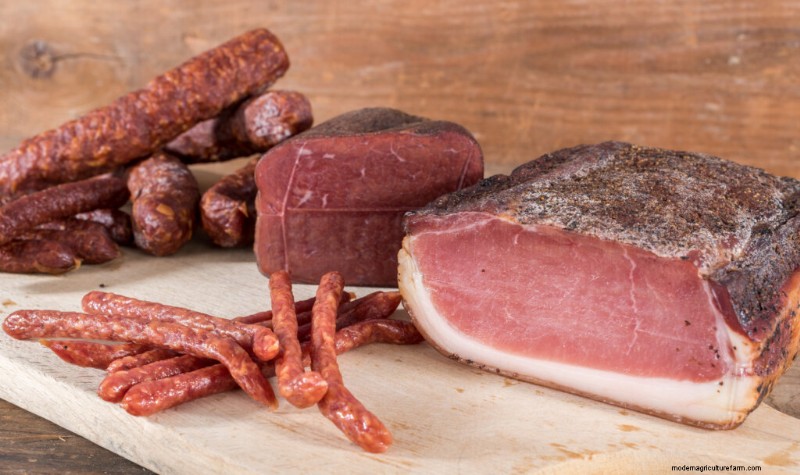
Você deve contratar um açougueiro?
Matamos muitos porcos em nossa fazenda. Uma vez que você aprende a fazer isso não é tão difícil, mas a primeira vez pode ser um pouco intimidante.
Todo o processo leva cerca de 3 dias. O primeiro dia é matar e enforcar, o segundo é esfolar e cortar os pedaços, o terceiro é geralmente o processamento de salsichas.
Uma desvantagem de se matar é que, a menos que você saiba
como curar bacon e presunto você não vai acabar com esses cortes (você vai ter presunto fresco que é muito bom, mas não como o presunto tradicional).
Os benefícios de matar a si mesmo são o know-how e a economia de custos. Tradicionalmente, o abate de um porco custa entre US$ 150 e US$ 250, dependendo do processamento e da cura.
O sabor é superior
Ao criar seus próprios porcos, você controla o que eles comem, o que contribui para um produto mais saudável para sua família.
Além disso, criar porcos é muito divertido e adoro observar suas travessuras. No entanto, acho que o melhor motivo para criar carne de porco é o sabor. Depois de experimentar, você nunca mais vai querer carne de porco de supermercado.
Mais sobre Amy

Amy é esposa e mãe de 18 filhos. Além de criar e educar em casa sua megafamília, eles também administram uma pequena fazenda familiar, que chamam carinhosamente de “
Autumn Creek Ranch .” Eles amam o trabalho de Joel Salatin (eu também!) e moldaram muito do que fazem por meio de seu exemplo.
Você tem alguma dúvida sobre a criação de porcos? Você pode enviar um e-mail para Amy em
[email protected] 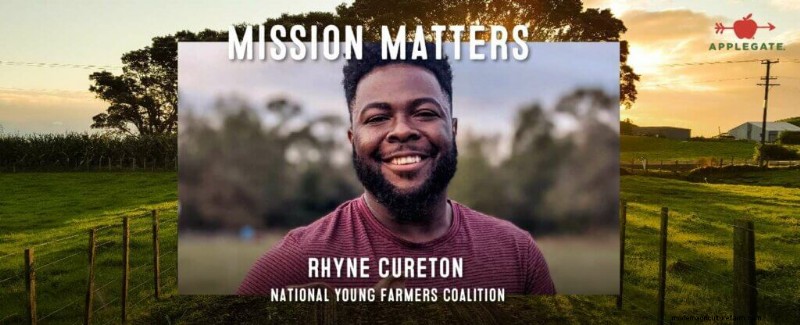
Mais sobre “Pork” Rhyne Cureton
Não deixe de ouvir o podcast (começando no minuto 41) para conhecer o trabalho de Pork Rhyne em países do terceiro mundo por meio da empresa EATBETA – Evangelizando a África por meio do Empoderamento Empresarial na Transformação da Agricultura.
- Pork Rhyne TV no YouTube
- Instagram
- Facebook
- Homesteaders da América
- E-mail:[email protected]
TranscriçãoE-mailDownloadNova guia
Melissa K Norris: Ei, pioneiros. Bem-vindo ao episódio número 331 do Podcast Pioneering Today ... Hoje vamos falar sobre um dos meus tópicos favoritos. Eu sinto que eles são todos os meus favoritos, mas isso é definitivamente alto lá, e isso é criar porcos. Já cobrimos a criação de porcos antes em diferentes episódios do podcast. Falamos sobre a raça Heritage American Guinea Hog conhecida ... Estou usando aspas, mesmo que você não possa vê-las ... mais ou menos como, AKA, "o porco do proprietário". Minha experiência, nas notas do programa, colocaremos um link para aqueles se você quiser conferir alguns desses episódios anteriores, minha experiência com eles.
No episódio de hoje, estou muito animado, porque vamos mergulhar nos porcos, mas vamos falar sobre muitos conselhos comuns ou frequentemente vistos quando se trata de criar porcos, especificamente na alimentação, o que você está alimentando seus porcos, manejo de pastagens e algumas outras coisas que muitas vezes são imprecisas, ou não necessariamente servindo o porco e o fazendeiro da melhor maneira. No episódio de hoje, vamos mergulhar com o convidado de hoje. Estou realmente animado. Você ouvirá, assim que começarmos a entrevista, como eu os conheci, um pouco da história por trás. Já vou avisando que, ao apresentá-lo, não deixe o volume muito alto. É só pelo primeiro minuto. Você entenderá por que digo isso quando chegar lá. É tudo muito divertido, e acho que você realmente vai gostar disso e do entusiasmo dele sobre o assunto.
Antes de chegar lá, o episódio de hoje é patrocinado pela ButcherBox, o que é bem apropriado, já que estamos falando de carne. Se você ainda não chegou a um ponto em sua jornada pela propriedade ou não tem um fazendeiro local de onde possa comprar sua carne, o ButcherBox facilita a obtenção de carne de alta qualidade, criada humanamente, na qual você pode confiar. Eles entregam carne 100% alimentada com capim e acabada com capim, frango orgânico criado ao ar livre e carne de porco de criação tradicional, juntamente com frutos do mar selvagens capturados, diretamente à sua porta. Na verdade, experimentamos todos os itens acima. Sempre veio e ficou completamente congelado, mesmo quando era no final do dia e no final da rota rural que percorremos para um entregador. Não tivemos nenhum que não tenhamos gostado. Fiquei muito impressionada com a qualidade, o sabor, a forma como cozinha. Tudo acima do acima, se não for algo que você possa criar sozinho.
Uma das grandes coisas é que, como você é um ouvinte do Pioneering Today Podcast, há um especial acontecendo até 20 de janeiro. É o Pacote de Ano Novo. Você pode obter sete quilos de carne grátis em sua primeira caixa ao se inscrever como um novo cliente na ButcherBox. Para conseguir isso, acesse ButcherBox.com/PioneeringToday. Isso é ButcherBox.com/PioneeringToday. Obtenha seus sete quilos de carne grátis em sua primeira caixa. Muito obrigado, ButcherBox, por patrocinar o Pioneering Today Podcast.
Se você é um novo ouvinte do podcast, seja bem-vindo. Um ouvinte de longa data, high five. Bem vindo de volta meu amigo. Meu nome é Melissa K. Norris. Sou um proprietário rural de quinta geração e ajudo milhares de pessoas, todos os meses, a aprender como viver uma vida caseira e artesanal usando uma propriedade rural simples e moderna, não importa onde você esteja. O convidado de hoje é conhecido como Pork Rhyne. Seu nome verdadeiro é na verdade Rhyne Cureton. Eu acredito que é assim que você diz. Ele é conhecido como um evangelista da carne de porco em todo o país, e até mesmo no exterior, na África Oriental, sobre o qual falaremos um pouco. Acho muito interessante e fascinante. Ele trabalha como educador agrícola internacional e especialista em marketing de nicho de carne. Por mais de cinco anos, Rhyne dedicou sua vida a treinar e educar agricultores experientes e iniciantes, principalmente na produção de gado de pequena escala, negócios e marketing. Com certeza vamos falar sobre a criação de carne de porco em um ambiente de propriedade de gado menor, então estou muito, muito animado em recebê-lo no podcast e falar sobre isso.
Para obter links para alguns dos episódios anteriores que mencionei e algumas das coisas sobre as quais falaremos, você pode acessar tudo isso em MelissaKNorris.com/331. Esse é apenas o número 331, porque este é o episódio 331. Novamente, MelissaKNorris.com/331. Vamos ao episódio de hoje.
Bem, eu estou super animado para este episódio. Vou avisar a todos. Vai ser muita energia, porque conheço muito poucas pessoas que tendem a ter o nível de energia que eu tenho. Sem mais delongas, Pork Rhyne, bem-vindo ao Pioneering Today Podcast.
"Porco" Rhyne Cureton: Estou animado. Estou animado. Você trouxe a pessoa errada aqui.
Melissa K Norris: Eu não penso em errado. Estou pensando certo. Adorei sua energia no HOA, então fiquei muito feliz. Estávamos conversando um pouco antes de começarmos a gravar, pessoal, e basicamente enviei a ele um convite para o podcast que não lhe deu oportunidade de desistir ou dizer não. Eu basicamente disse:"Ei, qual é a data e a hora em que você quer sair?" Estou muito feliz por ele ter aceitado meu forte convite armado. Estou realmente animado. Tenho a sensação de que vamos cobrir muito neste episódio, então vamos mergulhar direto nisso.
Uma das coisas, quando estávamos conversando, realmente [inaudível 00:06:06]. Você disse que vê muitas coisas oferecidas online. Vou presumir, porque gosto de presumir o melhor sobre todos, que muitas dessas coisas são oferecidas com boas intenções, mas você vê muitas coisas quando se trata de criar porcos online, ou frequentemente, devo dizer , que causa problemas ou pode ser problemático. Eu adoraria que você mergulhasse nisso um pouco mais.
"Porco" Rhyne Cureton: Oh sim. Oh sim. Vamos entrar nisso. Fundo sobre mim. Eu costumava cultivar. Vai voltar para a agricultura. Trabalhou com o National Pork Board em Pork Checkoff. Raças de herança levantadas quando eu cultivava. Vai voltar para raças de herança. Tenho ensinado pessoas a criar porcos, tanto em todo o país quanto no exterior, nos últimos cinco anos. Estou usando essa experiência porque vou falar sobre isso.
Uma das coisas que notei com as pessoas que estão entrando na criação de porcos, e nunca criaram porcos antes em toda a vida, provavelmente nem vêm de um passado agrícola, há muitos problemas questões em termos de alimentação, em termos de práticas fundiárias, em termos de bem-estar animal, e ouso dizer legalismo, quando entramos em grupos de apropriação, grupos alternativos aos padrões e modelos convencionais com a indústria suína. Tenho visto muita desinformação sobre quanto você deve alimentar seu porco.
Oh cara. Melissa, há tantas informações conflitantes. Deve deixar alguém louco, honestamente. Sinto muito pelas pessoas que estão começando a criar porcos e não têm ideia de por onde começar, ou vão a uma postagem de blog e depois a alguns vídeos do YouTube. Eles estão recebendo informações completamente diferentes. Não há realmente nenhuma consistência ou continuidade. A maioria das pessoas está procurando uma fórmula, como:"Qual é a fórmula que posso usar e obter sucesso?" O único mito que quero dissipar, um dos maiores mitos que já vi, lavagem de porco, é que não existe uma fórmula para isso.
Melissa K Norris: Um homem. Um homem.
"Porco" Rhyne Cureton: Não há absolutamente nenhuma fórmula. Agora, quando você entra na agricultura convencional comercial, na verdade existe uma fórmula. Se você seguir, você se sairá bem. Para as raças tradicionais, para pessoas que criam porcos ao ar livre, ou em pastagens, ou em celeiros, é muito diferente. Não tem essa consistência porque, A, você tem os elementos que afetam o quanto um porco vai comer. Por exemplo, quando está mais calor, os porcos não gostam de comer quando estão com calor. Eles simplesmente não. Eles não fazem nem um pouco. Então, sua capacidade de ganhar massa muscular e gordura diminui porque eles não estão comendo tanto. Certo? Quando está frio, eles comem muito mais, porque estão tentando usar grãos, ou o que quer que você os alimente, como forma de gerar calor para eles se manterem aquecidos. Não há realmente nenhuma consistência porque não estamos criando porcos em ambientes de ratos de laboratório. Nós simplesmente não somos.
Uma coisa que eu realmente promovo é ter um olho de fazendeiro. O que quero dizer com isso não é apenas alimentar um animal, dar-lhe água e abrigo. Não apenas essas coisas, mas todo o conteúdo entre elas. Certo? O que isso realmente requer são habilidades de observação. Você vai cometer erros. Bem, não você, Melissa, mas o público. [diafonia 00:09:44]
Melissa K Norris: Oh não. Eu cometo muitos erros, mas obrigado por isso.
"Porco" Rhyne Cureton: Tentando não te jogar debaixo do ônibus... Se você está cultivando e está começando, vai cometer muitos erros, em termos de alimentação, em termos de alojamento, em termos de bem-estar animal, e tudo bem. Há muita informação conflitante por aí, e muitas pessoas que estão fazendo vídeos ou blogs que não têm, necessariamente, o histórico que eu tenho ou o histórico que um criador de porcos convencional teria. Muitas pessoas estão aprendendo com pessoas que estão apenas começando. Muitas pessoas estão aprendendo como criar porcos com pessoas que criam porcos há um ano ou menos. Certo? As pessoas que criam porcos, e mesmo ao ar livre, por vários anos, cinco anos, 10 anos, 20 anos, não estão online porque estão muito ocupadas ganhando dinheiro criando porcos. Isso pode ser problemático em muitos casos.
Uma coisa que quero dizer é que tenha graça consigo mesmo ao começar e descobrir as coisas. Apenas entenda que não existe fórmula, e que essa fórmula muda com a raça, com o tipo específico de porco que você obtém. Mesmo dentro de uma raça, existem diferentes variações de tamanhos. Melissa, você cria porcos-da-índia americanos. Há um grande [inaudível 00:11:01] montando, e há alguns que foram feitos muito pequenos. A diferença no crescimento pode ser muito drástica entre esses dois tipos diferentes dentro dessa raça. Existem muitas nuances com porcos reprodutores.
Parte de mim agora, eventualmente, começando a TV Pork Rhyne é ser capaz de fazer as pessoas entenderem que você pode ter sucesso na criação de porcos dentro de seu contexto particular. O importante é ser flexível, ser capaz de aceitar críticas construtivas e ter habilidades de observação e utilizar essas habilidades de observação com melhores práticas. Já vi muita gente que infelizmente acaba caindo no legalismo. Eles estão dizendo:"Bem, esta pessoa cria porcos desta forma, então se você não está criando porcos desta forma, então você não é um bom fazendeiro." Eu ouço isso muito. Eu ouço muitas pessoas, como, "Bem, se você não está criando seus porcos no pasto, então você não é um bom fazendeiro." Bem, acredito que quase todo mundo pode criar porcos, e acredito que posso receber algumas cartas de ódio por isso. Não acredito que a produção de pasto para porcos seja o único caminho. Certo?
Melissa K Norris: Certo.
"Porco" Rhyne Cureton: Eu estive na África. Eles têm pradarias. Eles têm savanas. Eles não têm pasto. Se eles têm pasto, não estão colocando porcos nele. Eles estão colocando vacas. Eles estão colocando cabras e estão colocando ovelhas ali. Os porcos são a última coisa que eles vão colocar no pasto. Isso não faz absolutamente nenhum sentido. Além disso, eles têm predadores de duas pernas. Certo? Eles não têm apenas os animais selvagens de quatro patas. Eles têm predadores de duas pernas, também conhecidos como humanos, que realmente vêm e roubam seus porcos. Não há rede elétrica quando há quedas elétricas todos os dias ou algumas vezes ao dia. Certo? Eu gosto de olhar, qual é o contexto? Quais são seus recursos limitados? O que você tem? Qual é a sua experiência? Quanto tempo você tem para fazer isso?
Então, quando estou trabalhando com fazendeiros, apenas os ajudo a criar seu próprio plano dentro de suas limitações, gerenciamento de tempo, estilo de vida e da maneira que ainda permite o bem-estar animal adequado. Existem algumas pessoas que são muito legalistas, dentro do nosso setor particular de apropriação original e agricultura, que acabam realmente atacando as fazendas comerciais. Então, o problema que vejo é quando vou a essas fazendas de apropriação. Vejo animais em situações mais deploráveis do que quando vejo quando entro em uma situação comercial de suínos, ou mesmo quando vejo quando vou para a África Oriental. Explique isso para mim. Como uma pessoa pode ser contundente e sentir alguns, mas não ter o bem-estar animal adequado? That makes absolutely no sense, but this is something that I see a lot in common with people who want to have a formula for how they be successful, or want to be in legalism on there's only one way of doing something right. I truly don't believe that. I think there are multiple ways of having healthy hogs, and even a healthy family with those hogs.
Melissa K Norris: Sim. I completely agree with you on so many things, especially with the context in looking with where you at and working within the resources, and also understanding climate, as well as workload. Until very recently, actually, I worked a day job where I was commuting. I was a pharmacy tech and was commuting 18 miles one way. My husband still works off of our homestead and farm, so he still has a day job. For us, we do have our pigs on pasture, but we don't rotate them. They're not on fresh grass every day, simply because when you leave at 5:00 AM in the morning, and it's dark, and you're not getting home until sometimes 6:00 at night, if not later, there's only so many hours in the day. I think, just like you said, that that legalistic part ... Yes, no matter what method you choose to raise your pigs, you're going to want to make sure that you are raising them as ethically and as humanely as possible, but there's more than one way to do that.
I'm really happy that you're talking about that, and also looking at your climate, because, from our experience, the American Guinea Hogs that we had, it overall was a very pleasant experience that I have. Were They Worth It?: a different episode you guys can all go and listen to on that in drawing the difference between raising the Hereford versus the American Guinea Hogs. You really need to dig into your climate with the different breeds, as well as expectations.
I wanted to circle back to one of the things, and that is feed. Feed, not only how much, as you said, and definitely your climate, and the time of year, and so many things we're going to determine. The best thing is looking at the animal. Does it look healthy? Does it look underweight? Is it looking too fat, and [inaudible 00:15:45] ... but types of feed, because, as you know, that is also controversial. Who knew homesteading could be so controversial? I swear, every aspect of homesteading I talk about, there's controversy somewhere or another. I'd love to address that, because I know this is a thing where some people are like, "Well, just go. Go to the bakery and get day old bread that they're getting rid of." Then you've got your purists. Certo? There's all these things. Let's talk about them. Why is that a good idea? Why is that not a good idea? All the things. Let's dive into feeding pigs.
"Pork" Rhyne Cureton: Oh cara. You mentioned earlier of what does a healthy a pig look like? I think part of the issue is a lot of people who are starting raising pigs doesn't know what a healthy pig looks like.
Melissa K Norris: Sim.
"Pork" Rhyne Cureton: Or how a healthy pig behaves, so that's part of the reason why I'd say, before you get your pigs, spend some time volunteering on a local farm that has the practices that you want to have, if possible. That's not for everybody. Not everyone has the time or energy. Even if it's just like, "You know what? I'm just going to spend a weekend once a month going to a farm. They might be a couple of miles away, several miles away, but I want to learn how they're doing things and get acclimated," because when you're starting out with no understanding of a strong foundation of what a good animal looks like, of what good proper feed management looks like, then you're just shooting in the dark hoping that you hit something. Sometimes that might be at the detriment of your hogs. I've heard plenty of stories. Pigs die. Let me tell you something. It's hard to kill pigs. You have to really try hard to kill pigs, but I've heard plenty of stories of homesteaders that had mismanaged their pigs so poorly that they end up passing away.
Melissa K Norris: Uau.
"Pork" Rhyne Cureton: That's extraordinarily unfortunate. That's why I say get under somebody who knows what they're talking about, not just these people on YouTube or on the blog posts, but someone who's got five years of experience, even three years of experience raising pigs, and can give you a little bit of advice and guidance. If we're starting to talk about feed, one thing, at the HOA conference, I did a whole thing about alternative feed, because I know that's what homesteaders love to talk about. They love to talk about how they're getting alternative this and alternative that, and saving money here and there. Oftentimes I've seen pigs who are emaciated, or pigs who are obese, pigs who have carcass qualities that aren't what the homesteader intended them to have. Certo?
Melissa K Norris: Mm-hmm (affirmative).
"Pork" Rhyne Cureton: If you're expecting the meaty hog but you're feeding it nothing but carbohydrates, when it's time to process it, all you're getting is a really fat, obese pig. You're getting more lard than you probably know what to do with. Now, with homesteaders it's not as much of a problem, because a lot of homesteaders like to use lard.
Melissa K Norris: Um homem.
"Pork" Rhyne Cureton: Um homem. Thank the lard. Praise the lard.
Melissa K Norris: Sim. Sim.
"Pork" Rhyne Cureton: Praise the lard. Praise the lard. Hallelujah ... A lot of times it's like, "Oh, but I wanted more weeks. Oh, but my bacon, it's 90% fat and 2% actual muscle meat. Why is that?" I think the biggest thing is understanding what is feed? What are the components of feed? At the conference, I talked about how very simply, and I teach this in East Africa where I'm not speaking their language. I have to have a translator to do that, so I have to speak very simply. What I normally will say is feed is made out of carbohydrates. Examples of carbohydrates using feed, would be things like corn. Certo? Energy source. Certo? Think of carbs as energy sources. Then you have your protein source. Oftentimes a conventional feed will use soybeans as a protein source. Certo? Then you're thinking about fiber, minerals, other different aspects about feed that really go a long way in terms of having a healthy quality hog.
I can say, "Oh, well, just feed 16% protein, for protein feed, that's already been milled, and feed that to your pigs." Well, that's not completely accurate because, for American Guinea Hogs, they're so obesity prone that they really need to be on an extraordinarily limited grain diet. Certo? More opportunity for forage, so don't feed them a whole bunch of bread if you have lardy based pigs, unless you want a lot of fat and not a lot of meat. If that's what you want, perfect. Fine. You're doing a great job. If you're wanting more meat on your hog, but you're raising heritage, more lardier breeds, then you want to be really consistent and conscious about how much carbohydrates they're eating.
Let's say you have a meatier pig, like I would at Jason at [inaudible 00:20:44]. We had butchered a hog, and I was examining the meat quality. We talked about it, because he was really disappointed that he didn't get a lot of meat. I asked him, "Pick nine million questions." At the end of it, it came out to the fact that, potentially, his pigs were being fed organic 16% crude protein feed all the way throughout their entire life. Certo? Oftentimes, when we start practicing more proficient swine husbandry, around two months to three months before the pig is going to be slaughtered, we actually reduce the amount of crude protein down to 14%. Maybe even 12%, depending on the breed. The reason why we will do that is because we want to reduce the amount of protein and increase the amount of carbohydrates, because if you increase the amount of carbohydrates, what that means is you get more fat. They'll going to store all that energy into fat. Certo? If you think about people who eat meat, versus people who eat nothing but bread. One of these is going to get fatter than the other. Certo?
Melissa K Norris: Mm-hmm (affirmative).
"Pork" Rhyne Cureton: That's one way of really looking at it is from that aspect, but it depends on your breed. For people who are raising, again, larder based breeds, you've got to be really mindful about how much to feed your pig grain, or anything that's floured, or baked goods. That, too. Otherwise, you'll get a lardy pig and not a lot of meat. If you have more muscular pigs like the Herberts ... I dare even say Gloucestershire Old Spots, Tamworths, Durocs, then that's not going to be a huge concern. You actually want to make sure that your pigs do gain fat before processing, so you want to actually increase your carbohydrate load before their processing date by two months. I would have enough fat cap on them to where you get flavorful, delicious pork, because fat is where the flavor is at.
Melissa K Norris: That's why we like bacon.
"Pork" Rhyne Cureton: Bacon, yes.
Melissa K Norris: Sim. That's fascinating. Speaking of the timing and the climate, as you were talking, with our Herefords, when we raise and butcher them we typically butcher in October, which means from August on we've got tons of apples around here. We actually make up an apple mash that we feed them in order to supplement the organic food that we're buying for them, and because we're butchering them in October, we've got apples all the way out to finish them. They're not a lardier breed, like you said. As you were talking, I was going back over it. With the American Guinea Hogs, we actually kind of reversed that, because we butchered them the end of January. The last two months before butcher date, we didn't have any apples left, because obviously by then we'd went through all that we had, just because of the time of year. Their carbohydrates actually got reduced the last two months before butcher. Of course, I still got massive amounts of lard.
Talking about feed and the carbohydrates, as well as their protein sources. As I said, we like to supplement with apples when we can, which is a fruit. There's fiber in there, but obviously [inaudible 00:23:58] vegetables from the garden, and all of that. When you're looking at specific protein sources other than soy, and I personally try to avoid soy. With every study under the sun, you're going to find a study that can kind of back you up one way or the other, it seems. I personally try to avoid soy, especially conventional soy, because of GMOs.
"Pork" Rhyne Cureton: Wow, you sound like you're from the Midwest. GMOs.
Melissa K Norris: Certo? I can adapt accents here. When you're looking at protein sources, if you're trying to go the route of producing more of the pigs' feed on your homestead, what would be some other protein sources that one could look at?
"Pork" Rhyne Cureton: Good question. Before I even talk about, I have to say that the source of protein, if you're buying feed, is generally the most expensive ingredient in your feed bill. A, that's why when you reduce your crude protein from 16 to 14, you note that there's a significant difference in cost. It is important to figure out, what are some other ways of finding something other than soybeans? Cool fun fact about soybeans. The reason why it's so popularly used globally has nothing to do other than the fact that they were able to market the soybeans very well on the global level. That's all it had to do. There are alternatives such as rapeseed, pearl millet, the grain variety, sunflower seeds, and even field peas, that equival, if not exceed, soybeans in terms of crude protein. I think field peas are a really good way of either having food plots up for your pigs and allowing that being a source of protein. The trade off would be that you have to be really mindful of timing when your pigs enter into that food plot. I know some farmers will actually grow several acres of their local variety of field peas.
Some work better in different climates. In the Georgia, North Carolina area, iron clay peas work very well. Iron clay peas probably wouldn't work well where you're at, Melissa. They'll bale those fresh peas. They'll bale it all, and they'll make it into a silage, or something like that, that they'll feed throughout the year. That's one way that people get around that. If you're not at an efficient economy of scale, meaning that you don't have a lot of acres, you don't have a lot of machinery, it can be really challenging.
I've got one friend. He'd go to Chipotle, and he gets beans from Chipotle. That's what he does, is he gets the beans from Chipotle. Actually, he gets the beans, the chips, all the things from Chipotle, and he feeds that to his hogs. He also raised American Guinea Hogs. He never really spent a dime on actual feed. Do I recommend that? I only recommend that if it is not post-consumer. I repeat, not post-consumer. I do not recommend post-consumer restaurant scraps. What I mean by that is someone ate it, took a bite into it, threw it in the trash, and then that restaurant collected that food scraps and then gave it to the farmer. That farmer gave it to the pigs. That's a good way of spreading diseases. I don't recommend that.
Restaurants will have scraps or leftover food that didn't go to the consumer, because it's still sitting on the bar. Then what they'll do is, if you're working with a farmer, the farmer will say, "Hey, just put it in a bucket, or put it in a trash container. I'll provide the trash container for you. You just dump it out. Just make sure that there's no pork in it." Do not feed your pigs pork.
Melissa K Norris: Sim. Yes, for the love.
"Pork" Rhyne Cureton: They might give them $20 for a couple of trash cans, or something like that. Something people, they're like, "Don't even pay us. We're just glad that this waste is going towards something good and meaningful." That's a way that you can kind of do it. If you're trying to grow your own grain, your own protein source, it's going to be really challenging. That's why a lot of people just go to buy bagged feed anyway. Again, bag feed is more expensive, unless you have the acreage, or, I daresay, unless you work with farmers who have the acreage. You don't have to do everything on your own. I talk to plenty of farmers who don't have the same amount acreage that they would like to have, but they're still getting field peas, sunflower seeds, pearl millet, rapeseed, from other farmers who are nearby, and just partnering with them. That way it's more of a cooperative effort, rather than, "I have to figure this out all by myself and all on my own."
Melissa K Norris: Sim. That's why, really, with our climate and the amount of acreage that we do have, we have purchased supplemental organic pig feed mix. We actually have a local granary mill that's about an hour away from us. That feels good because they try to source from as many local farmers as they can, and it is certified organic, which is important to me. I know that's not important to everyone, and that doesn't mean that everybody has to go that route. We do pay more for that feed. Again, that's a personal choice.
I love the suggestion of Chipotle, and the reason I love that is because they actually have a non-GMO stance, and have for a really long time. As far as looking at getting food sources outside of from a farmer, but a restaurant, even though it is a chain, that's probably one of the best ones that you could pick. I love that you gave that suggestion.
"Pork" Rhyne Cureton: Oh, great. Also, a pro tip. If you're using spent grain, just understand that 80% of spent grain is actually water. You're not getting the nutritional value out it. Spent grain, if it was dried, would have 26% crude protein. No, actually, I take that back. 29% crude protein. If it's wet, which is what people mostly get spent grain, it's only 7.7% crude protein, so misconceptions with that. Also, spent grain gets moldy very quick. I don't recommend spent grain as a primary feed source. I recommend it as an add on to an already complete diet [crosstalk 00:30:46]
Melissa K Norris: Wait. I don't even know that terminology. What does spent grain mean?
"Pork" Rhyne Cureton: You think of brewer's grain.
Melissa K Norris: Oh, tudo bem.
"Pork" Rhyne Cureton: Brewer's grain.
Melissa K Norris: OK. I had never even thought of going that route, but I'm glad that you made that distinction for us. I'm learning all kinds of new things. Eu amo isto. We might just have to have a part two and have you back on. See, I think that-
"Pork" Rhyne Cureton: Sim. Sim.
Melissa K Norris: Yeah, because I've got so many more things that I want to ask, but I want to try to keep this somewhat concise. My listeners know conciseness is really not a skillset that I have developed, though I am working on it. Going back to a little bit of the breeds, because I think that's where we get enamored with heritage breeds. Entendo. I love heritous way. I grow an all heirloom seed garden. I love heritage, and I love being able to protect them. There's also a reason that hybrids, both in breeding programs, as well as garden seeds, have been developed. Can you talk a little bit to picking heritage versus other breeds, and then within heritage breeds? I know this could be an entire complete episode all on its own, getting into this. Within the heritage breeds, certain things to consider when you are picking a heritage breed, if that's the route you choose to go.
"Pork" Rhyne Cureton: Eu amo isso. Yeah, let's get into that. With heritage breed pigs, some background on me, my first pigs were heritage breed. They were English Large Blacks. There's something about those Large Blacks. They're the black pigs with the super floppy ears. They look extraordinarily adorable. You can't see their eyes because their ears are covering it. Then Red Wattle. Then I've raised crosses, some of them heritage variety, the Hampshire and Duroc, as well as commercial Yorkshire. I'm grateful that I've had those different experiences. I've even bred, both purebred, as well as hybrids.
One thing that I'll say with heritage is that there's a reason why they're heritage. They do extraordinarily well in low input situations. What I mean by that is 100 years ago, 200 years ago, 300 years ago, these pigs were not being fed a strict grain diet. I'll repeat that one more time. They were not pampered. They were not pampered pigs that got fed a strict grain diet. They just weren't. They were getting fed any old kind of thing, from house scraps, slaughter waste. Then, once fields were harvested, they'll send the pigs out to clean up the fields. Certo? Pigs were low input animals, just like chickens. That allowed for a lot of people to be able to have a meat source that was low input, meaning that that was saving them money. In fact, pigs used to be able to ... We can't say this so much today, but they used to be able to really be a life saver for a lot of families when crops failed that year. At least they had pigs to pay off any bills, their mortgage. Whatever it might've been.
One of the issues that we have today is that we have switched more to a commercial hog. Part of the reason of that is because somewhere around the, I believe, 40s, 50s, or 60s, somewhere in between there, there was a crisis on heart disease. People were trying to out what's causing heart disease. It came down to two things: sugar related products, and fat related products, including fat industries. Unfortunately, there was some falsified information, and sugar ended up winning. Fat ended up being the blame for heart disease. What ended up happening with that was ... That's why you have yogurt that's low fat. It literally says low fat, but like 12 grams of sugar in a cup. People don't understand that sugar, when not utilized properly, converts to what? Fat.
Melissa K Norris: Yes, and insulin resistance issues, and so many different things.
"Pork" Rhyne Cureton: Keep preaching, Melissa. Keep preaching. That's part of the reason why a lot of these animals went out of favor. They also went out of favor because, around the Industrial Revolution in this country, we realized that we can produce synthetic oils, cheaper vegetable oils, as a way of machinery. We were using whale blubber to oil trains. Now we're using more synthetic oils to be able to use machinery. That's another reason why pigs also went out of favor. Also, these pigs grow very slow. In terms of homesteaders, if you're getting heritage breed pigs, they will grow slower than your commercial pigs. Usually commercial hogs are ready at around six months, and they weigh somewhere between 280 pounds to 300 pounds. Usually around 280 at six months. Those are for your commercial hogs. Now, when you get a heritage breed, you do have some variation. Your Herefords ... What other breeds are there other than Herefords? Your Tamworths. Other more meatier breeds. Usually they're at 680. Sorry, 280, if not 300 by eight months. Certo?
Melissa K Norris: Mm-hmm (affirmative). Sim.
"Pork" Rhyne Cureton: Usually I'll say grow them out for an additional two months to get more back fat on them. Then you have your lard pig like your American Guinea Hogs. That can take a year to a year and a half, depending on the particular type of American Guinea Hog. English Large Blacks can take 10 years. Sorry, 10 months, to a year, a year and a half, to reach around 260. Right? There are a lot of different variations with the breeds. I highly recommend, if you want more information on the comparisons, just look up heritage hog breed comparisons chart. You should be able to find that at the LivestockConservancy.com. Sorry, .org. That'll give you way more information than you probably want to know on each individual breed from that standpoint.
Another thing to consider is, with heritage breeds, the medium breeds do very well with retail cuts. However, that's where they shine, because they provide more muscle mass. Isso é ótimo. With your lard based pigs, like your Mulefoot, your English Large Black, your Kunekunes, your American Guinea Hogs, they weren't made for, necessarily, meat production. They're made really more for fat production, with fat actual more valuable than the pork itself. They really shine in sausages and ground pork. They shine very well in charcuterie. Part of the reason why a lot of people who are raising lard based pigs are having issues with marketing their pigs is because they're marketing as if they're retail hogs, and they're not. They're absolutely not. They need to be marketed and treated a lot differently.
Again, fat is where the flavor is at. When you're doing bratwurst, no better bratwurst than a lard pig bratwurst. That's the best bratwurst you'll ever have. Best sausage you will ever have. Best charcuterie you're going to ever have compared to your more leaner breeds, even on the heritage side. If you're raising these heritage breeds, especially the large ones, start thinking outside of the box from retail cuts, because if you try to make pork chops out of an American Guinea Hog, your pork chops are going to be small. Your-
Melissa K Norris: You got sent lots of fat.
"Pork" Rhyne Cureton: A lot of fat. [inaudible 00:38:51] going to be extremely tiny. You can probably put a pencil through that. Think about it from the standpoint of I can sell these pigs, wholes and halves. I can turn them into charcuterie. I can turn them into ground pork and sausage, and maybe keep the bacon, depending, and hams. Hams, if you're going to use ham charcuterie as well. They don't shine well with pork chops. They don't shine very well with leg roasts, or Boston butts, or sometimes even bacon, or pork chops. They don't shine well doing those things, so stick to the shrimp of the pigs.
When I used to work for the Livestock Conservancy, I did change some of the utilization descriptions for the breeds. If you go on their website, LivestockConservancy.org, and look at the breed profiles, on the side you should be able to see the utilizations for those breeds. They should be up to date, because I did update them before I resigned from there. Those are my thoughts on that.
Melissa K Norris: OK. Incrível. I love that, because the American Guinea Hog was the best bacon we've ever had, bar none. The ham was fatty, but when I cooked it in the slow cooker, and then shredded it. Oh my gosh. It was amazing, but it's not like a spiral cut, when you think of spiral cut hams. That is not what you were getting. I'm with you there, definitely. If you we raise the American Guinea Hogs again, I probably will just raise them for the bacon, and the sausage, and a couple of the ham cuts. We won't even bother with the pork chops. I have to say, the pork chops were delicious because of the fat, and quite moist, but yet you're getting such little meat per pork chop cut. I almost have to cook six for our family of four just to barely get enough meat for everybody. I'm really glad that you brought those points up. It's kind of like, do we get a couple of American Guinea Hogs just for the bacon and sausage, and then raise the Herefords? Não sei. We'll see what we end up doing.
Some amazing resources in today's blog post that accompanies this episode. We will provide all of the links and different things that Rhyne has been so gracious to point us in the direction of. One of the things you had mentioned that I wanted to talk about and just, myself, learn more about, is your work in Uganda with raising pork. Can you tell us a little bit more about that? I find that fascinating.
"Pork" Rhyne Cureton: Sim. Yeah, definitely ... I lost my train of thought.
Melissa K Norris: It happens.
"Pork" Rhyne Cureton: I go overseas to East Africa, Uganda, as well as Tanzania, or Tanzania if you've got a country accent. I teach people, basically, in very simple manners, how to raise pigs within their context. I'm really blessed by that experience, because it allowed for me to really look at farming more contextually ... I made a rookie mistake. I remember my first year going. I go into an organization called EATBETA. It's E-A-T-B-E-T-A. It stands for evangelizing Africa through business empowerment and the transformation of agriculture. We're not simply about giving money to people. We're about how do we train and educate people on best practices with their business and with their farm.
One slogan that I use when I go over there is farming is business. Farming is business. I don't care if you're in it from subsistence living, or if you're trying to make money off of it. It's always a business, because you're having inputs, and there are outputs. Certo? Usually that requires some type of economic or capital to be able to make that thrive. When I go over there, I'm working within their context. They don't say soybeans. They say soya. They don't say corn. They say maize bran. They're having limited ingredients and limited resources. They're using different even feed additives like sunflower seed cake, and fish meal, and all these other things. Being able to understand that not all of them are at a place where they can raise healthy pigs, it's really important. It's even sad sometimes when I have to recommend that they not raise pigs, because they're not at that scale.
I daresay, even to your audience, you might not be at a scale where it's economically viable for you to raise pigs. I want to let you know there is no shame in that. Absolutely no shame in that. Stick to chickens. Grow that chicken operation out a little bit more, whether it's egg production or meat birds. I recommend meat birds, and scale up from there. That's what a lot of people have done to really be successful with raising pigs. They start out small. They start out with chickens, and then they build up to pigs, and then they'll build up to cattle, or maybe the goats and sheep. That's probably a really good model for East Africa is showing people that you can scale up your farming operation. You have to do it incrementally. A lot of people who are philanthropists will just donate tractors to East Africa. Certo? These people don't know how to use a tractor. Most of them don't. When something breaks down, they can't fix it.
When my team goes down there, we're not teaching how to use a tractor. We're teaching, how do you hand plow? How do we get you from a hand plow, or hand hoe, to a hand plow, where you're actually tilling the Earth through a hand mechanized plow? We're doing funding for that, and we're giving those out. It's appropriate technology, appropriate training and education, rather than we're just going to give money, rather than we're just going to fix all your problems. No. We're going to teach, how do you run a business? When I go over there, I teach farming is a business, and I teach people that animal welfare, because there are a lot of issues with animal welfare in countries that would be deemed third world or developing. People over there don't treat pigs like pets. They treat pigs like stupid dirty animals.
Part of what I do is I teach animal welfare is not necessarily the primary goal. The primary goal is economics. The primary goal is making money. Well, if I know that their real issue is they want to make money, then I equate proper animal welfare with higher profitability. For example, if you are putting your pig on a more standardized feed ration, your pigs grow out faster, meaning you get your money quicker. Very simple and easy. Certo? If I talk about how reducing your herd if your herd is unmanageable, you have too many pigs, and you can't afford to have too many pigs, by reducing your herd and just sticking to a few and feeding those well, it increases your reputation. Now, you're having pigs that are actually at weight. People are getting that pork, and they're getting the quality pork that they're wanting, rather than emaciated pigs. Certo? That increases reputation. That means comeback customers.
When you're dealing with breeding, thinking about when you're really treating your sow with respect. Not beating it. When you're really giving your sow enough water, enough feed rationing, then that allows for you to have healthier piglets. That allows for your piglets to be weaned to survival, and then that means more profit per pig. Certo? Everything really can boil down to economics when I go over there, and that's allowed for me to translate that back to the states, and really show people that every decision that you make as a farmer has an economic impact. It will always have an economic impact, whether big or great, or small or great, small or great.
That allows for a lot of people to see that their decision to switch feeds, that's an economic decision. Can you afford to do that? If not, that's okay. There's no shame. Or I want to do this opportunity with sausage, or opportunity with a live event. Okay, cool. What's the economic impact on your farm, and how much money will it cost? That really gets people thinking about, "How do I save money, or how do I reduce my costs, or how do I become more profitable in the enterprise I already have?"
Melissa K Norris: Uau. I love all of that. That, again, is an entire 'nother episode. We could probably talk for hours and hours and not get through everything, but this was great. Eu realmente gostei disso. Would love to have you come back on. For those who are wanting to learn more about you, learn from you, check out more about your farm and the work that you're doing, what's the best place for people to connect with you?
"Pork" Rhyne Cureton: People can connect with me on ... People have been begging me to start a YouTube channel, and I resisted it for, I think, about a year. I recently have made a channel, and I'll be posting videos on it by the end of this week. Whenever you have this recording out, I will have already posted videos. Essa é a melhor maneira.
Melissa K Norris: OK.
"Pork" Rhyne Cureton: I am considering leaving Instagram, so I won't be on Instagram. Then, for emails, you can email me at Rhyne, R-H-Y-N-E, @PorkRhyne, P-O-R-K, R-H-Y-N-E, .com.
Melissa K Norris: Incrível. Now, I know Rhyne is your first name, but my great grandmother's last name was Rhyne. I just had to throw that fun little tidbit out there. Spelled exactly like yours.
"Pork" Rhyne Cureton: Legal. We're long lost cousins. That's all it is.
Melissa K Norris: Yeah, I agree. This has been a blast. I can't wait to learn more from you, and just be able to share that knowledge to get more people raising more of their own food, and taking control of their food source. Thank you so much for coming on today.
"Pork" Rhyne Cureton: Um homem. Um homem. Glad to be here, and I appreciate what you're doing with your podcast and your YouTube channel. You're one of the few folks in that space where I don't cringe when I watch a video, so just thank you for the good work that you're doing, and the honesty that you have behind it. It really means a lot to me.
Melissa K Norris: Aw, thank you. I hope you had as much fun as I did with today's episode and picked up some tips if you are planning on raising your own pork, or maybe you already have pork, but you were able to glean some tips and some ideas on where you could get some extra feed without a bunch of extra expense, which I know that always gets me super excited when it comes to our homestead endeavors. Well, this episode was all about raising pork, or mainly about raising pork.
Next week, I have another really fun episode for you where we will be having a guest, and we will be talking about homesteading, but, in particular, gardening. Especially if you have young children, or children at home, how to get them incorporated, but also still how to have a garden and try to stay sane. If you have infants, or toddlers, or really young children, it can often be hard trying to juggle it all. We are going to dive into this. I had so much fun doing these episodes. I know you're going to enjoy them just as much as I do. That is coming up for you next week. Blessings and mason jars for now.
Scroll back to top
Sign up to receive email updates
Enter your name and email address below and I'll send you periodic updates about the podcast.
distribuído por
Other Articles You May Enjoy
- Planning Your Livestock for a Year's Worth of Meat Per Person
- Our Food Production Plan &How to Plan for Livestock
- 5 Tips on Raising Livestock for Food
- Keeping a Family Milk Cow- 8 Things You Need to Know
- Um guia para criar cabras
- Tudo o que você precisa saber sobre a criação de coelhos para consumo
- Como manter os animais frescos no calor
- Maximizing Your Homestead for Profit &Production (With Joel Salatin)
- Commonly Believed Homesteading Myths

















